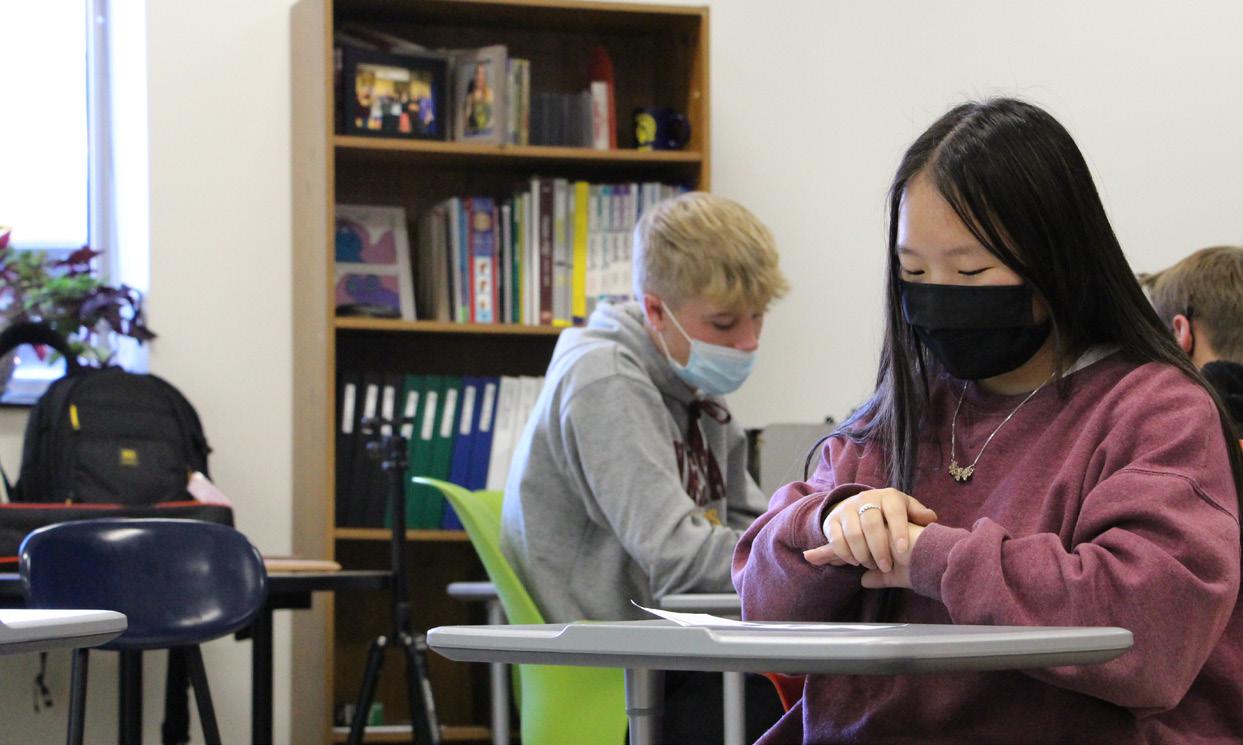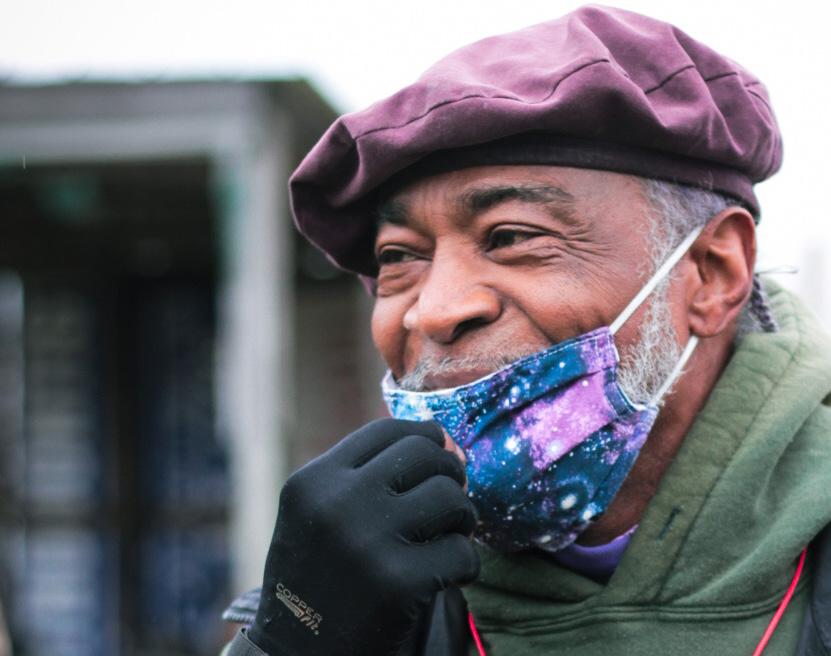
9 minute read
The line between beauty and suffering
All in on American Sign Language
Tiffany Moore teaches students to adapt to those different from them.
Advertisement
By Makenna Cook
Mahtomedi High School teacher Tiffany Moore stands in the front of her classroom in front of around 30 students during the sixth hour, the last hour of her high school day. | Photo by Makenna Cook As one of the Deaf teachers signed his high school algebra lesson to his seven students, Tiffany Moore shrunk into her chair. She watched from the back corner of a first hour math classroom on her first day of student teaching at the Minnesota State Academy for the Deaf. It was just math, but she felt like she barely understood the numbers.
‘Holy crap! I can’t handle this,’ Tiffany Moore thought to herself.
She hadn’t used American Sign Language in three months.
Throughout the school day Moore began to feel more comfortable with the language difference. In her last class, the teacher was a CODA, or Child of a Deaf Adult. His signing used a structure closer to spoken English.
“I just melted into my chair, I was like, I understand 100% of what’s happening here,” Moore said.
Moore grew up being taught that if she was going to do something, she needed to go all in. Being immersed in an environment where she was the linguistic minority was her version of “all in”.
Moore grew up in the small town of Somerset, Wisconsin in a time where American Sign Language was rarely offered in schools. After seven deaf babies had been born in the area, the district hired a deaf and hard of hearing teacher to work part time with those students and part time teaching American Sign Language. From the first class, Moore was hooked.
“It was just something that I was good at. Something I understood. It’s a way of communicating that I like. I knew that from the very beginning,” Moore said. “So while I didn’t say, ‘I’m going to do this for my life,’ it was always in the back of my mind.”
During January of her sophomore year at Augustana University, she returned to her district’s elementary school for her first practicum to work with the younger Deaf siblings that had recently started preschool. As Moore walked into the classroom of three four-year-old boys, the love and excitement from them is what she remembers most.
“Not very many people in their environment knew how to sign, so coming in as an outsider, but still knowing how to sign, was just so positive,” Moore said. “They loved having another person who signed, a big person who signed.”
That positive feeling is what she fell in love with. She has seen it play out repetitively throughout her whole career, whether it be thousands of families driving to Faribault, Minnesota to attend the Deaf schools homecoming football game or seeing the smile on her hearing students faces as they recall moments that they were able to communicate with Deaf customers while serving ice cream at a local ice cream shop.
Moore stood by the wooden door of her first floor classroom at Mahtomedi High School. Students sat in swivel chairs with desks attached to them as they chatted out loud with their peers. Moore flicked the light switch twice then clapped her hands together. The room fell silent. It was time for class.
Moore isn’t afraid of silence and she doesn’t let her students fall asleep in it. Flickering lights, clapping hands, and stomping feet on the floor are all just part of the routine. This routine has been Moore’s entire career.
Mahtomedi High School placed ‘American Sign Language 1’ in their registration booklet to get a number of how many students were interested. Over 100 students responded positively. They needed a teacher.
Moore had never considered teaching American Sign Language until Mahtomedi High School contacted her. They knew she had a degree in Deaf/Hard of hearing

education and that she had been out of the workforce for a few years to raise her children. They wanted to start a Sign Language program.
After acquiring her ASL teaching license, Moore began at Mahtomedi High School in 2015 with four full class periods of American Sign Language 1 students.
“I would take my books home to study. Not because I didn’t know sign language, but because I didn’t know the why of it. In order to teach it, the why of it is very important.” Moore said.
Through teaching, she came to another realization – English teachers focus on the four aspects of language: speaking, listening, reading, and writing. ASL only has two of those, speaking/expressive and listening/receptive.
Even after teaching ASL for seven years Moore still spends hours on Pinterest and American Sign Language teacher support Facebook groups collecting and developing activities where her students can speak and listen.
“When you take away half the possibilities, you really have a lot of time to play with,” Moore said.
Activities range from describing articles of clothing from the piles in the school theater costume closet to writing out their schedule for the week and communicating with one another to try and book an appointment.
“The program has grown over the years. When it first started, Mrs. Moore was not teaching it full time,” Mahtomedi High School counselor John Atkins said. “It has grown to include college level ASL coursework and college credit through MSU Mankato.”
Moore put in the work to build the program from four classes of American Sign Language 1 to six classrooms ranging from ASL 1 to ASL 5. By the end of the four year high school program, students have enough skills to fulfill college language requirements, and earn college credits during their time in high school. More importantly to Moore, they are able to adapt when they come across someone different than them.
“There’s a whole bunch of students who I know are going to remember ASL. They’re going to be able to list it as a special skill on their resume,” Moore said. “And perhaps at their place of business later in life, they’ll be the go to person who has just enough ASL skills that Deaf clients can be funnelled to them. I think that’s very valuable.” But Moore knows that’s not the case for some of her students. Her goal teaching American Sign Language is not for every student to remember all of the vocabulary for the rest of their lives. “My goal with my students is that when in life, they meet someone that they don’t expect, someone very different from them their mind stays flexible and they can absorb and handle and do what they can do.” Her life experience in the Deaf community showed her that flexibility is what the hearing community needs the most. Teaching American Sign Language gives her the opportunity to be “all in” on making that change. Designed by Ariel Dunleavy
Check out this video for more information about Tiffany Moore. | Video by Makenna Cook

Seeds of reparation
Community activist Melvin Giles works to promote peace through his gardening and peace bubbles.
By Soroya Kieser
Melvin Giles tells angry people to put their hands in dirt because the dirt can calm them down.
Washed away, shoveled away, thrown away dirt. Because dirt is Giles’ lifeblood. Without dirt
Giles would not have tended his family garden as a child, growing collard greens and peppers and tomatoes until it became a hobby and not just a chore. Without dirt
Giles would not have remained as connected with his neighbors whom he bugged until they would install a box garden in their backyards. Without dirt Giles would not have started the Urban Farm and Garden Alliance, bringing fresh fruits and vegetables to the Rondo community in St. Paul starved of green. Without dirt Giles would not have begun planting the seeds of reparation.
Giles and his family – mom, dad and three older brothers – moved to the Rondo neighborhood of St.
Paul, now known as the Frogtown and Summit-University neighborhoods, in the late ‘60s, just as Interstate 94 was being completed. At the time, I-94 wasn’t a sign of racial discrimination to Giles. It was a winter playground.
Vivian Mims, Giles’ long-time friend and neighbor, recalls sledding and playing “King of the Hill” on mounds of dirt covered in snow left on the highway to await the thaw that meant continued construction.
Every thaw also meant gardening. Giles’ dad, Reverend Robert Giles, was an avid gardener, and gardening was a requirement for the Giles sons. After Giles’ mom died when he was 12, gardening became father-son time, and Giles learned to love tending the shoots and weeding the rows.
Another neighborhood activity was always football.
Football on the blacktop of Wilson Junior High. Football in the side yard. Football on Aurora Street. Football as a running back and defensive back for Central High School. Football. Football. Football. Sometimes Giles and his friends would pretend to be Alan Page, one of the Vikings’ defensive line of dirt-smeared “Purple People Eaters” who eventually became the first Black man to serve on the Minnesota Supreme Court. Or Bobby Hayes of the Dallas Cowboys, a black man and the only person to win both an Olympic gold medal and a Super Bowl ring. Two people who showed Giles that success was possible for people who looked like him.
“For a Black kid, that meant something without even knowing that it meant something,” Giles said.
Driving through a Chicago suburb on the way home from a funeral with his brother Metric, Giles was stopped by the police and told that he and Metric looked like the suspects of a robbery. Soon six police cars were surrounding Giles’ blue Chevy Nova SS. Every piece of luggage was searched, but all the police found were the Giles’ dress clothes from the funeral. That didn’t stop the police from escorting the brothers to the convenience store they had supposedly robbed, searching their luggage once more and finally letting them go after the owner said it wasn’t them.
Driving with his brothers, Giles has been stopped countless times by the police. Oftentimes officers didn’t explain why.
Giles has lost count of the number of times a gun has been pointed at his face.
Giles started off college studying economics and history at Clark University in Atlanta, Georgia. — a breath of fresh air from St. Paul. Dubbed a “Chocolate City,” Giles became part of a Black community unlike any he had experienced before. Giles watches as urban gardeners pick beets at Live Organically. | Photo By Soroya Kieser






